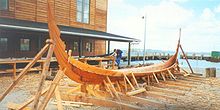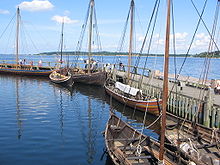Longship
As longships refers rowing boats that are much longer than it is wide. Many ancient cultures , including great seafaring peoples, knew longships.
Greeks
Greek longships were rowing ships that were built by the Greeks as early as the 1st millennium BC. BC, before the development of galleys with several rows of oars . These ships (for example, the types of ship Pentekontere (fifty rudders ) and Triakontere (thirty-three rudders)) were sometimes of considerable size: the length of a Pentekontere is estimated to be 35 to 40 meters.
The oldest mentioned longship is the Argo in the Argonauts legend , on which Jason and the Argonauts drove to Colchis to conquer the golden fleece .
The Greek longships became - probably around 800 BC. BC - the Bireme developed.
Roman Empire
Some Roman and late antique ship types can be described as long ships, for example. B. the Navis lusoria .
Saxony
The Saxon long ship or long boat was a parallel development to the Viking long ship and very similar to it.
In 1939 a longship of 24 meters in length was found in Sutton Hoo on the River Deben , East Anglia , which in the 7th century served as the grave for an Anglo-Saxon king, probably Rædwald the Red.
Vikings
The Viking longship is a type of ship that was primarily used for military purposes. Merchant ships were called Knorr and were significantly wider. The early long ships, such as the 23-meter-long Nydam ship from Nydam / southern Denmark from the 4th century, which is on display in Schleswig , were still pure rowing ships. Later longships had a mast with a square sail . The rudder was attached to the starboard side. Every ship also had to have an anchor.
The longships were rowed and sailed. The draft of the longships was only 90 cm when fully loaded and they reached a maximum speed of 15 to 20 knots . They were extremely fast with both the sail and the oars. When rowing took place, the rowing team had to be constantly changed over long distances, which increased the number of crews and made them difficult to determine. In addition to being able to travel long distances, the Vikings could not only sail with their ships in shallow waters, but also penetrate deep into the interior of the country along the rivers, even under flat bridges. They succeeded in going up the rivers so quickly that even messengers on horseback could no longer give advance warning. In addition, the shallow draft of the ships made it possible to land quickly on sandy beaches.
Many ships could also be transported certain distances overland. It is said of Olav the Holy: "(The King) had the ships brought over the ridges between the lakes."
As already described, the speed of the Viking ships was considerable. This is also proven by driving tests with various replicas. The average speed over long distances should have been around 7 knots , which corresponds to the maximum speed of a family sailor today. In 1893 Magnus Andersen made a trip from Norway to New York with a replica of the Gokstad ship . In favorable wind conditions it reached 11 knots (almost 20 km / h). Magnus Andersen was able to prove that the Gokstad could be steered with just one man, even in rough seas. The fact that the hull was able to yield to the forces of the water due to the elastic frame connections turned out to be extremely advantageous. In just 27 days, it crossed the Atlantic twice as fast as a replica of Christopher Columbus' Santa Maria . The particularly short Heimlösa Rus with around 10 meters reached 12.4 knots. With the - also relatively small - Helge Ask , a replica of the shipwreck No. 5 from the Roskilde Fjord, 14 knots were reached. There is much to suggest that the larger and slimmer longships were able to achieve significantly higher maximum speeds.
The seaworthiness was just as remarkable. In 1968 a group of 32 Danish scouts drove up the Thames with the longship replica Imme Gram and tried to capsize the ship. Despite all efforts, this did not succeed.
Much information about the construction of longships comes from ship graves . It was customary in Viking society to bury kings under an elongated burial mound in a ship with rich grave goods. The ship grave in Oseberg in Norway (Viking long ship) is a good example of this.
Asia
see dragon boat
See also:
- Viking shipbuilding , history of Viking shipbuilding
- Several longships lie in the Skuldelev ship graveyard
- Knorr (ship type)
See also
literature
- Dirk Husemann: Reform backlog in the dragon boat. in: Adventure Archeology. Spectrum of Science Verl.-Ges., Heidelberg 2006, 1, 78ff. ISSN 1612-9954
- Dirk Husemann: Reform backlog in the dragon boat. in: Spiegel-Online. dated March 12, 2006.
- Frédéric Durand , Les Vikings et la mer , éditions errance, Paris, 1996
- Rudolf Simek: The ships of the Vikings , Reclam Stuttgart 2014, ISBN 978-3-15-010999-1
Web links
- Sinking of the Ormen Friske (warning of design errors in replicas of Viking ships)
- The Lapuri Fund (English)
- Viking ship
- Private replica of a small Viking boat (lots of information & pictures)
Individual evidence
- ↑ Heimskringla Ólafs saga helga. Cape. 121.



